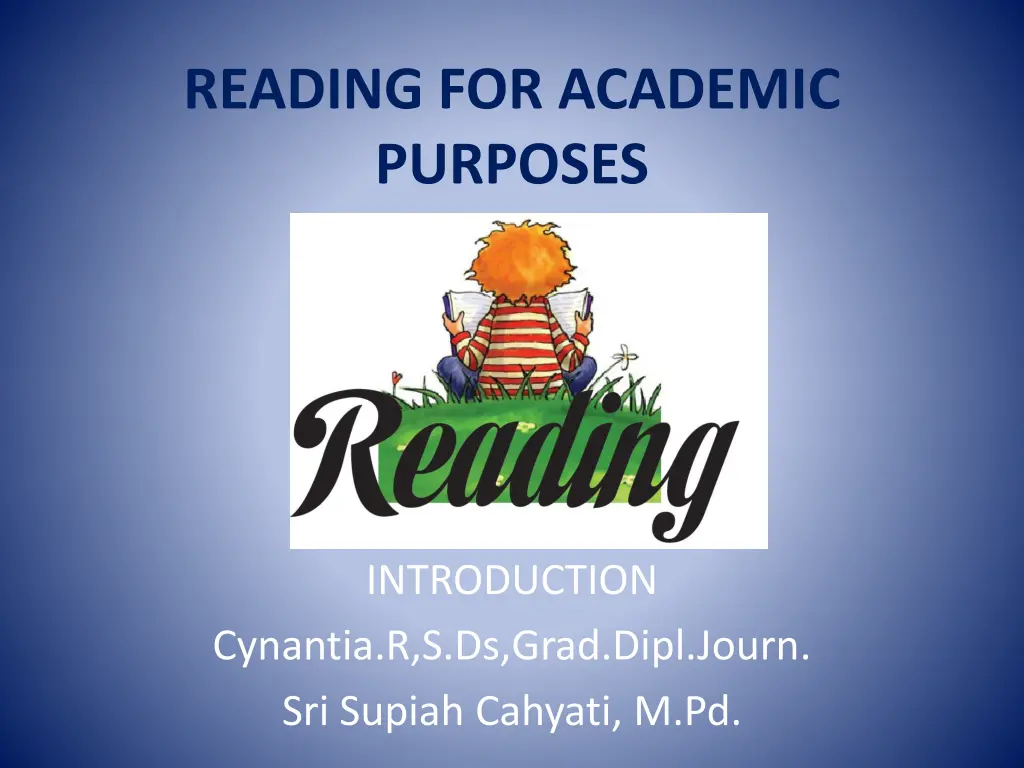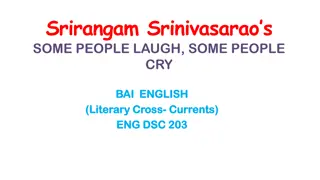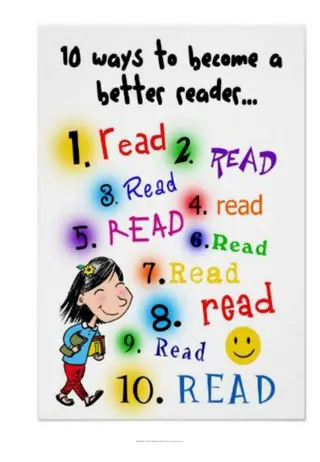
Enhancing Academic Reading Skills
Improve your academic reading skills with tips on efficient reading strategies, the importance of active reading, and the impact of reading techniques on comprehension and writing. Discover how to engage with texts effectively and develop critical thinking skills to enhance your learning experience.
Download Presentation

Please find below an Image/Link to download the presentation.
The content on the website is provided AS IS for your information and personal use only. It may not be sold, licensed, or shared on other websites without obtaining consent from the author. If you encounter any issues during the download, it is possible that the publisher has removed the file from their server.
You are allowed to download the files provided on this website for personal or commercial use, subject to the condition that they are used lawfully. All files are the property of their respective owners.
The content on the website is provided AS IS for your information and personal use only. It may not be sold, licensed, or shared on other websites without obtaining consent from the author.
E N D
Presentation Transcript
READING FOR ACADEMIC PURPOSES INTRODUCTION Cynantia.R,S.Ds,Grad.Dipl.Journ. Sri Supiah Cahyati, M.Pd.
Ask yourself this question: Do I read every word in my own language when I am reading a schedule, summary, or other outlining document? The answer is most definitely: No! Reading in English is like reading in your native language. This means that it is not always necessary to read and understand each and every word in English. Remember that reading skills in your native language and English are basically the same.
In groups of three or four, discuss your own reading ability. What makes a good reader? Are you a good reader? What is your main problem when reading? What strategies have you developed for reading?
Students need to take individual responsibility for learning. Much more reading is needed than just the lecture notes or course guide. Developing your reading skills is of paramount importance.
it is not simply what you read or how much you read but how you read that will crucially affect your level of reading skill (Boddington and Clanchy, 1999, p. 1). How you read will impact on your understanding of source material and the way you incorporate these sources into your own writing on a topic.
READING FOR ACADEMIC PURPOSES READING IS NOT DULL
Critical reading and thinking skills require active reading. Being an active reader means you have to engage with the text, both mentally and physically. So, here s what to do
Skim ahead and jump back. Skimming ahead enables you to see what s coming up in your reading. Page through the text you re about to read. Notice how the text is broken down, what the main topics are, and the order in which they are covered. Notice key words and ideas that are boldfaced, bulleted, boxed, or otherwise highlighted. Skimming through the text beforehand will prepare you for what you are about to read. It s a lot like checking out the hills and curves in the course before a cross- country race. If you know what s ahead, you know how to pace yourself, so you re prepared to handle what s to come.
Mark up the text. Marking up the text creates a direct physical link between you and the words you re reading. It forces you to pay closer attention to the words you read and takes you to a higher level of comprehension. Use these three strategies to mark up text: 1. Highlight or underline key words and ideas. 2. Circle and define any unfamiliar words or phrases. 3. Record your reactions and questions in the margins
Make specific observations about the text. If you don t have a dictionary readily available, try to determine the meaning of the word as best as you can from its context that is, the words and ideas around it. Then, make sure you look up the word as soon as possible so you re sure of its meaning.
READING FOR ACADEMIC PURPOSES TYPES OF READING
Skimming Skimming is used to quickly gather the most important information, or 'gist'. Run your eyes over the text, noting important information. Use skimming to quickly get up to speed on a current business situation. It's not essential to understand each word when skimming.
Examples of Skimming: The Newspaper (quickly to get the general news of the day) Magazines (quickly to discover which articles you would like to read in more detail) Business and Travel Brochures (quickly to get informed)
Scanning Scanning is used to find a particular piece of information. Run your eyes over the text looking for the specific piece of information you need. Use scanning on schedules, meeting plans, etc. in order to find the specific details you require. If you see words or phrases that you don't understand, don't worry when scanning.
Examples of Scanning The "What's on TV" section of your newspaper. A train / airplane schedule A conference guide
Extensive reading Extensive reading is used to obtain a general understanding of a subject and includes reading longer texts for pleasure, as well as business books. Use extensive reading skills to improve your general knowledge of business procedures. Do not worry if you understand each word.
Examples of Extensive Reading The latest marketing strategy book A novel you read before going to bed Magazine articles that interest you
Intensive reading Intensive reading is used on shorter texts in order to extract specific information. It includes very close accurate reading for detail. Use intensive reading skills to grasp the details of a specific situation. In this case, it is important that you understand each word, number or fact.
Examples of Intensive Reading A bookkeeping report An insurance claim A contract
READING FOR ACADEMIC PURPOSES DO s and DON T s
Keep an eye on the time: it will probably seem to pass very quickly, so take care not to spend too much time on any one passage or question. Remember that you only have 60 minutes to answer the questions and to transfer your answers to your Answer Sheet. Start at the beginning of the test and work through it. If you cannot do a particular question, leave it and go on to the next. You can then return to that question later if you have time. Put a mark next to this question on the Question Paper so that you can find it again quickly. Answer as many questions as you can.
Look carefully at the title of the passage and any subtitles and illustrations it may have. You can get a quick idea of what the passage is about from these. Read the instructions for each set of questions very carefully: it is important to do exactly what you are asked to do. Where appropriate remember to skim the questions before reading the passage so that you have a purpose for reading.
Use the glossary, if there is one provided, to help you understand unfamiliar words. Pay attention to any examples that are provided. Make sure that your answers keep to the word limit asked for: if you are asked for NO MORE THAN THREE WORDS , for example, then do not write more. Make sure that you copy words accurately from the text: spelling mistakes will mean that you will lose the mark for that question.
Don't waste time reading the whole passage each time for each set of questions. Remember that many task types ask you to locate or check details in the text. In cases like this you need to skim quickly through the passage rather than read it all carefully. Don't go back to the beginning of the passage for each question when you know from the task type that the answers will come in the order of the information in the passage. Don t forget that questions can come before the reading passage as well as after. Don't become anxious if there are questions you cannot answer. Leave them and move onto the next questions. You can always come back to the ones you couldn t answer at the end of the test if you have time.
Dont worry if you dont understand every word. It may not be necessary to understand all the words in order to answer the questions correctly. Don t forget that you must write your answers on your Answer Sheet. You will not be given extra time to do this at the end of the test. Don t write more than one answer when only one is required; even if one of your answers is correct, you will not receive a mark.
READING FOR ACADEMIC PURPOSES STRATEGY ON READING
Think about your reasons for reading the text: you are interested because it is about your subject, or it is related to your subject you want background information, or detailed information you want to know what the writer's views are you are going to have a discussion you are going to write an essay on this subject later
Survey the text: read the first and last paragraphs and the beginning and final sentences of the other paragraphs. How close were your predictions? Do you have a very general idea of the structure of the text, what the different parts are about?
VOCABULARY With the new words which you think are important: if an approximate meaning is enough, try to guess the meaning using word function, context (immediate and wider) and word form
DIFFICULT SENTENCES Divide the sentences where there are connectives or markers. What do the connectives mean? Underline reference words. What do they refer to? Identify complex noun phrases. Expand them using verbs and/or relative clauses so that they are easy to understand. Find the subjects, verbs and objects which go together, and, if necessary, write the whole sentence out in several sentences to show the meaning.
AFTER READING Make a list of the new words which you think will be useful for you in the future. Give: definitions of the words indication of whether they are nouns, verbs, adjectives etc. phrases in which the word occurs other words with the same meaning other forms of the words
READING FOR ACADEMIC PURPOSES UNDERSTANDING TEXT
Reading is purposeful. The way you read something will depend on your purpose. You read different texts in different ways. In everyday life, you usually know why you are reading, you have a a question and you read to find the answer.
When you read a novel, it is different. You start at the beginning and slowly move towards the end. In academic reading, you need to be flexible when you read - you may need to read quickly to find relevant sections, then read carefully when you have found what you want. General efficient reading strategies such as scanning to find the book or chapter, skimming to get the gist and careful reading of important passages are necessary as well as learning about how texts are structured in your subject.
Reading is an interactive process - it is a two-way process. As a reader you are not passive but active. This means you have to work at constructing the meaning from the marks on the paper, which you use as necessary. You construct the meaning using your knowledge of the language, your subject and the world, continually predicting and assessing. MacLachlan & Reid (1994) talk about interpretive framing, which influences your understanding.
Extratextual framing - using your background knowledge and experience to understand texts. Intratextual framing - making use of cues from the text, such as headings and sub-headings and referential words such as "this" and "that" to understand texts. Circumtextual framing - using information from the cover of the book, title, abstract etc. to understand the text. Intertextual framing - making connections with other texts you are reading to help to understand your text.
READING FOR ACADEMIC PURPOSES CRITICAL READING
It is important to read critically. Critical reading requires you to evaluate the arguments in the text. You need to distinguish fact from opinion, and look at arguments given for and against the various claims. This also means being aware of your opinions and assumptions (positive and negative) of the text you are reading so you can evaluate it honestly.
A Purpose and background Why are you reading this text? What is your purpose? What type of text is it: research report, essay, textbook, book review? What do you know about the subject of the text? What else has been written on the subject of the text? What controversies exist in this area? How does this text fit in?
The author and the text Who is the author? What do you know about the author? What authority does the author have? Who is the intended audience? What is the author's purpose? Why has the text been written? What is the source of the text? Is it reputable? Who is the publisher? What reputation to they have? What is the date of publication? Is it appropriate to the argument? What is the writer's attitude towards the topic? What conclusions are drawn?
Evidence used Is there a clear distinction between fact and opinion? Is evidence used to support arguments? How good is the evidence? Are all the points supported? In an experimental study, was the sample size adequate and are the statistics reliable? Are there any unsupported points? Are they well-known facts or generally accepted opinions? How does the writer use other texts and other people's ideas? Are the writer's conclusions reasonable in the light of the evidence presented? How do the conclusions relate to other similar research?
D Assumptions made What assumptions has the writer made? Are they valid? What beliefs or values does the writer hold? Are they explicit? Look at the language that is used, e.g. active/passive verbs, nominalisations, pronouns, ergative verbs, articles, etc. Is it always possible to identify participants and processes? e.g. compare: the government increased taxes; they increased the taxes, taxes were increased; taxes increased; the taxes increased, there was an increase in taxes Look for emphatic words such as it is obvious, definitely and of course. Look for hedges: possible, might, perhaps. Look for emotional arguments, use of maximisers: completely, absolutely, entirely, or minimisers: only, just, hardly, simply, merely. How else could the text have been written?






















